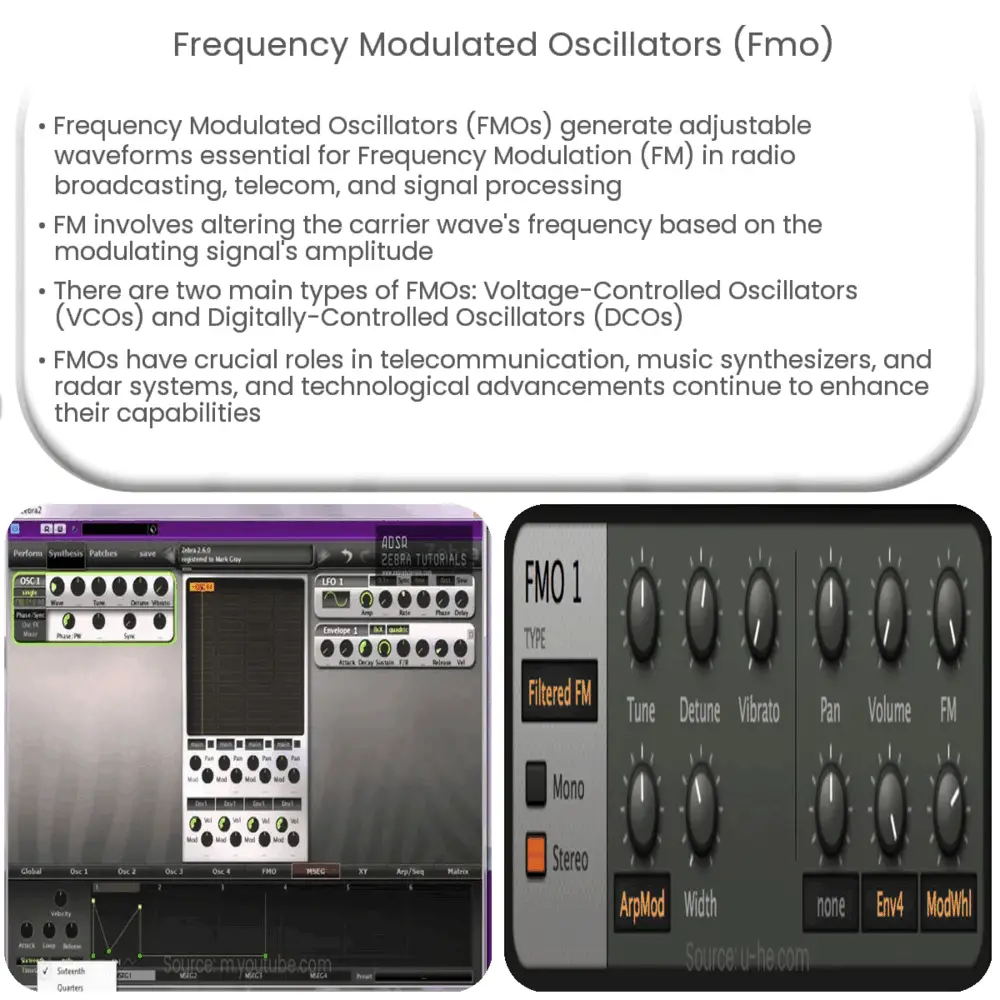Explore the world of Frequency Modulated Oscillators (FMO), understanding their operation, types, applications, and their role in modern electronics.

Introduction to Frequency Modulated Oscillators (FMO)
A Frequency Modulated Oscillator (FMO) is a core component in many electronic systems, responsible for generating a waveform with a frequency that can be adjusted or “modulated” based on an input signal. This concept forms the basis of Frequency Modulation (FM), a method widely used in radio broadcasting, telecommunications, and signal processing.
Understanding the Basics of Frequency Modulation
Frequency Modulation is a scheme of signal modulation in which the carrier wave’s frequency is altered according to the instantaneous amplitude of the modulating signal. It’s essential to understand that the frequency of the oscillator is not changed randomly, but rather it follows the variations in the input signal.
- Carrier Wave: This is the original or “unmodulated” wave, which is modified by the input signal in the process of modulation.
- Modulating Signal: This is the input signal that causes changes or “modulates” the carrier wave.
- Modulated Wave: This is the final output wave, whose frequency has been changed in accordance with the modulating signal.
Role and Operation of Frequency Modulated Oscillators
FMOs play a pivotal role in Frequency Modulation. They generate the carrier wave, which is then modified by the input signal. But how does this process actually work?
In an FMO, the frequency of the output waveform is controlled by a voltage input. When there is a change in the input voltage, the frequency of the output wave changes correspondingly. The rate of this change is called ‘frequency deviation’. The input signal is used to vary this controlling voltage, hence modulating the frequency of the output waveform.
- The input signal is first amplified to achieve the desired level of modulation.
- This amplified signal is then applied to the controlling voltage of the oscillator.
- As the controlling voltage changes, the frequency of the oscillator’s output waveform changes in accordance.
This process results in the creation of the final modulated wave, marking the successful operation of a Frequency Modulated Oscillator. This wave can then be transmitted over long distances, carrying the original information signal with it.
Types of Frequency Modulated Oscillators
There are several types of FMOs, each designed for specific applications. The two main categories are:
- Voltage-Controlled Oscillators (VCOs): In a VCO, the frequency of the output wave is directly proportional to the input voltage. They are widely used in synthesizers, phase-locked loops (PLLs), and frequency modulation radios.
- Digitally-Controlled Oscillators (DCOs): In a DCO, the frequency of the output wave is controlled by a digital input, usually a binary number. DCOs are frequently used in digital synthesisers and software-defined radios.
Applications of Frequency Modulated Oscillators
FMOs have a wide array of applications, notably in:
- Telecommunication: FMOs are used in radio and television broadcasting, cell phones, and satellite communication. FM radio is a popular example of this application.
- Music Synthesizers: FMOs are used to generate different waveforms and pitches in synthesizers.
- Radar and Navigation Systems: FMOs play a crucial role in radar transmitters and GPS systems, enabling accurate detection and positioning.
Advancements in Frequency Modulated Oscillators
Technological advancements have led to significant improvements in FMO designs. Today, modern FMOs offer higher frequency stability, lower phase noise, and wider tuning ranges, all while maintaining their compact size and low power consumption. Furthermore, the introduction of software-defined radios and digital signal processing has expanded the possibilities for FMOs in advanced communication systems.
Conclusion
In conclusion, Frequency Modulated Oscillators are an essential element of many modern electronic and communication systems. Their ability to generate and manipulate waveforms forms the basis of Frequency Modulation, making them integral to numerous applications, including broadcasting, telecommunication, and music production. As technology continues to advance, we can expect to see FMOs playing an even greater role in our increasingly interconnected world.



